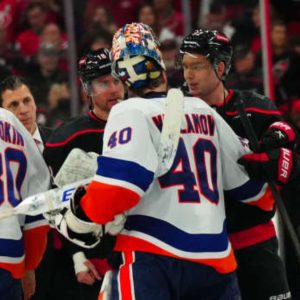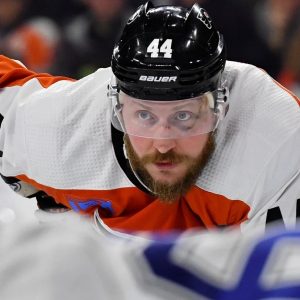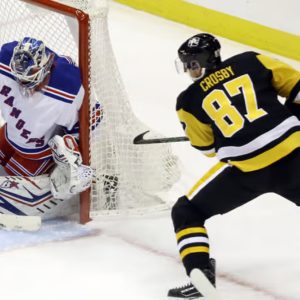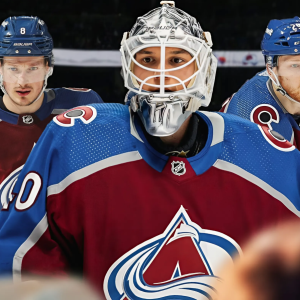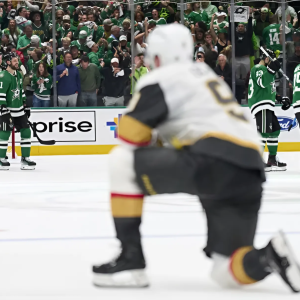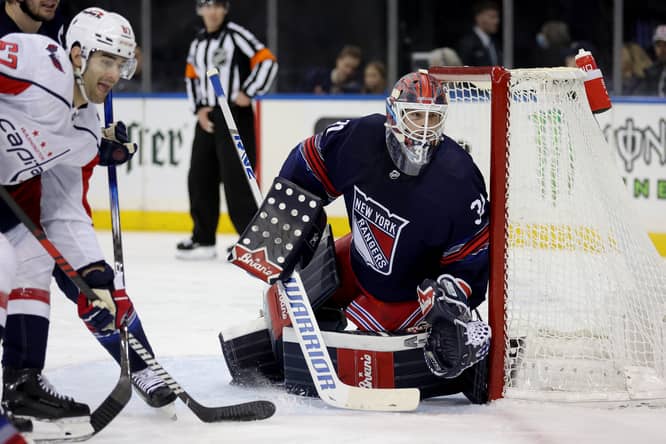
The New York Rangers have some decisions looming in the near future, but none is bigger than the fate of star goalie Igor Shesterkin, who can become an unrestricted free agent next offseason.
Shesterkin is among the best goalies currently in the NHL, and the backbone of a Rangers team that’s reached the Eastern Conference Final in two of the past three seasons, and won the Presidents’ Trophy in 2023-24.
The two-time All-Star won the Vezina trophy in 2021-22, and has a .921 save percentage and 2.43 goals-against average in 213 NHL games, with a crazy 135-59-17 career record. He’s been even more magical in 44 Stanley Cup Playoff games, posting a 2.41 GAA and franchise-best .928 save percentage when it maters most.
For those reasons, Shesterkin’s asking price for his upcoming contract is rightfully steep. The question boils down to whether he’ll stand pat on a reported 14 percent of the cap asking price ($12.9 million AAV) or if he’s willing to take a Jalen Brunson-esque pay cut in order to bolster the rest of the team.
Should Rangers make Igor Shesterkin highest-paid goalie in NHL history?
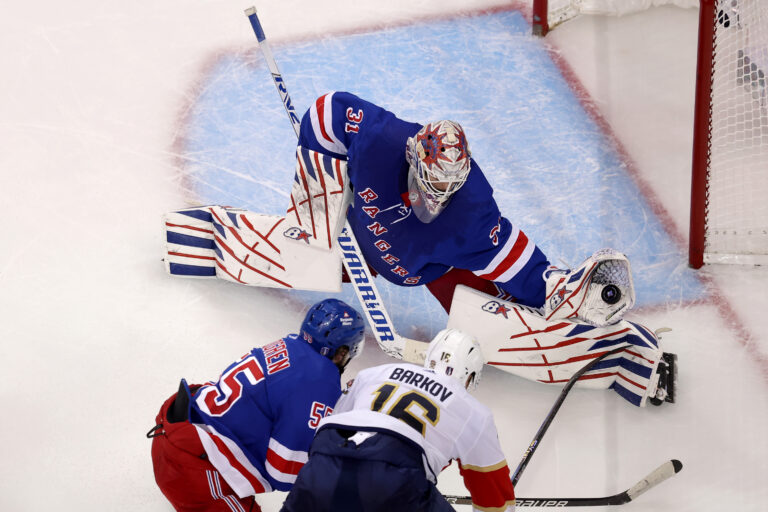
Forever Blueshirts staff writers Lou Orlando and Nick Palmer discuss whether the Rangers should pony up and meet Shesterkin’s asking price. Let the debate begin!
LO: Offering players a blank check is not a wise and responsible way to run an organization, but if anyone is deserving of that treatment, it’s Shesterkin. There’s not a player on the roster, including Artemi Panarin and Adam Fox, who is more singularly important to the Rangers success than Igor, particularly when the postseason rolls around.
Has he succeeded in carrying the Blueshirts to a Stanley Cup Final yet? No. But it’s hard to imagine that they even reach the Eastern Conference Final in either 2022 or 2024 without his play in net.
Shesterkin shined in their two trips to the conference final. He ranked either first or second in GSAA among all postseason goaltenders. Even in their first-round exit in 2023, he finished second in GSAA despite playing just seven games – and that’s a counting stat. So even when it feels like the entire team is struggling to make anything happen, which unfortunately has been the case too often when the ice tightens, Shesterkin has remained reliable in net and one of the few things keeping the Blueshirts competitive against elite postseason competition.
If the big gripe about the Rangers, from fans and the media, is their overreliance on goaltending and special teams, then you can’t afford to lose the goaltending part, even if a potential $12.9 million AAV price tag is tough to swallow.
NP: Igor Shesterkin is undoubtedly a crucial piece of the playoff puzzle for the New York Rangers, but is it wise to put all your eggs in his basket? Or, is it more prudent to spread the wealth and make sure that general manager Chris Drury can field a competitive team for years to come?
The hard truth for the Rangers is that no matter how well Shesterkin has played, they haven’t made it past Game 6 of the Eastern Conference Final with him in net. That fault lies largely with the rest of the team, though. There are only so many apologies Vincent Trocheck can offer Shesterkin after the Rangers fall flat in the postseason.
If it’s not Igor’s fault the Rangers can’t make it over the hump, would it make sense to weaken the team’s future with a ridiculous goaltending contract?
Plenty of teams in recent memory have won the Stanley Cup fielding modestly-paid goalies. Jordan Binnington was making $650,000 per year when he earned the moniker “Winnington” and led the St. Louis Blues to their first Stanley Cup championship in 2019. Adin Hill was making $2.175 million per year and carried the Vegas Golden Knights to their first Stanley Cup championship in 2023. Darcy Kuemper earned $4.5 million per year as a starting goalie for the Colorado Avalanche in their Stanley Cup winning year of 2022.
Sure, Sergei Bobrovsky with his $10 million cap hit just won the Cup with the Florida Panthers.
But $12.9 million? Good heavens. Shesterkin would become the highest-paid goalie and second-highest paid player in NHL history, and the Rangers would be nowhere closer to a Cup than they were after getting eliminated last season.
LO: $12.9 million is a lot of money. You are right about that, dear Nicholas. But I’m not sure it will be as debilitating as you think. It would certainly make things difficult in 2025-26 when Panarin’s $11.4 million is still on the cap and Alexis Lafreniere and K’Andre Miller will need new RFA deals. However, with the cap on track to rise by $5 million every season, and potentially even more after the next CBA, I don’t think it will handcuff Drury from building a competent roster.
Like with any massive deal, you take a big risk investing so much money into one player, knowing that if it fails, the repercussions will be long lasting. But how can you not invest in Shesterkin?
How many current goalies can you say are consistently Top 5, Top 10 in the League year-in and year-out? Look at what happened to Ilya Sorokin, who followed up a second-place Vezina finish and ninth-place Hart Trophy finish in 2022-23 with a 3.01 GAA and .908 save percentage this past season and was replaced by Semyon Varlamov in the postseason. Consistently elite goalies are few and far between – if you find one, you can’t let them go.
For every Binnington or Hill, there’s an Andrei Vasilevskiy. As stacked as they were, the Tampa Bay Lightning don’t make three consecutive Stanley Cup Finals, and win two, without their $9.5 million AAV goalie playing at an elite level every season. The Los Angeles Kings don’t win two Stanley Cups without Jonathan Quick, who was making nine percent of the cap in 2014. And of course, Cobrovsky this season.
It feels like those consistently elite goalies are harder to find now than they were 10 years ago. Nothing is a guarantee, but Shesterkin feels like a safe bet to remain one of the best in the League for the better part of the next decade.
With goaltending in such a volatile state, consistency is key. The Rangers should try their darndest to get Shesterkin down to $10 or $11 million annually, but if it comes to $12.9, then that is the price for something that is hard to find and even harder to keep.
NP: Elite and consistent goalies are hard to come by, you’re spot on there. There’s never been a doubt about Shesterkin’s ability to convert year-in and year-out. The issue arises with cap maneuverability, and whether or not the Rangers are in a healthy position to offer such a large contract.
Even with the cap space increasing next year, it will be more than difficult for Drury to maneuver.
Just take a look at the contracts that are already hurting the Blueshirts. Jacob Trouba is a thorn in the Rangers’ side, eating up $8 million per year and costing them even more on the blue line, though he’s got just two years left on his deal. He’s not the player the Rangers thought they’d get watching him quarterback PP1 in Winnipeg, and can’t stay healthy.
Another contract that could turn ugly is Mika Zibanejad’s, who after securing a lucrative eight-year, $8.5 million AAV deal, has failed to show up in the way that the Rangers need him to in the postseason. Zibanejad was thought to be a top-10 center in the League, an elite two-way forward with a piercing shot and quick passes.
Where was that Zibanejad when the Rangers really needed him? He fell flat when New York needed him most, not to mention he only posted eight 5-on-5 goals in the regular season. He looked timid on the ice and fell silent in the postseason after the Capitals series, going pointless in all but one game of the Eastern Conference Final.
Long and expensive contracts are already hurting the Rangers. Is throwing another one on top of that advisable, even with Shesterkin’s presumed consistency?
It leaves the Rangers vulnerable to roster inflexibility should unforeseen slumps arise. And we’ve seen them arise. Constructing a more well-rounded lineup of skaters could help prevent catastrophe from the contracts already on the verge of spoiling.
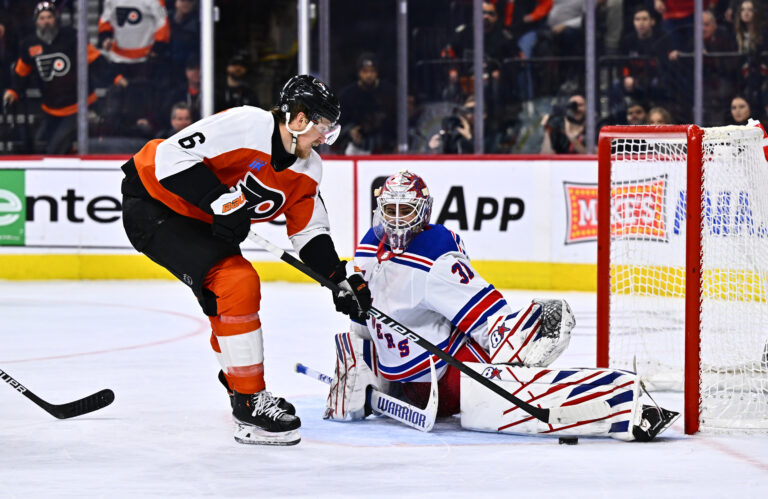
LO: Rangers fans have heard this story before. It’s the same tale that was spun with Hall of Famer Henrik Lundqvist, who signed two contracts that each accounted for a bit more than 12 percent of the cap.
I would argue that the Rangers never managed to successfully build a Cup-worthy team around him, except perhaps in 2015 when injuries to Ryan McDonagh and Mats Zuccarello played a major role in their Game 7 loss to the Lightning in the ECF. Perhaps this is my heart speaking instead of my head, but I still wouldn’t trade in the 15 seasons with Lundqvist for anything.
Hank made you feel like you had a chance in any series because you could always have the advantage in net. We’re nearing that territory with Shesterkin.
When you dole out big contracts to big players, it raises the importance of being shrewd and efficient with your money. That’s the case with any big deal though. When you give $11.4 million to Panarin or $9.5 million to Fox, it means there will be less maneuverability with your role players. That’s the price of having stars.
It doesn’t mean keeping those stars long term isn’t worth it. While signings like Nick Bonino, Tyler Pitlick, and Blake Wheeler didn’t pan out, Drury has found success bargain bin shopping with players like Quick and Jimmy Vesey.
Perhaps it means the Rangers will have to become more reliant on youngsters. Will Cuylle rewarded their faith in him with a strong first full season. Who knows what Gabe Perreault, Brennan Othmann, and Brett Berard can provide when their time comes?
The elephant in the room is that the Rangers’ window with this core is closing. Panarin has two years left on his current deal. Zibanejad and Chris Kreider will be under contract until 2029-30, but it would be foolish to think that they’ll remain elite into their late 30s.
The Rangers’ mission statement and overarching goal is to snap the 30-year drought win the Cup – that’s a message we hear from front office and players alike. Maybe a Fox-Lafreniere-Perreault core will keep the team playing at an elite level, but right now, their best chance to win the Stanley Cup is in the next few seasons. You can’t look yourself in the mirror and call yourself a “Cup or bust” team if you cheap out on Shesterkin.
NP: That’s true, Lou. The window for a Cup is narrowing, and will likely be shut after Panarin’s contract is up.
But where does that leave the Rangers if they don’t win it all in the next two years?
It leaves them with an elite Shesterkin riding out the remainder of his contract with a young team led by Lafreniere and Fox, and if the kids work out.
As Zibanejad and Kreider age, the Rangers are just a few years away from needing to enter a short rebuild stage. How will they remain a contender when a huge percentage of their cap is going to Shesterkin, especially if they plan on re-signing Panarin. The 120-point man may not command $11.6 million per year in his mid-thirties, but he will certainly find a near double-digit figure should his elite play continue.
While I believe that Lafreniere and Fox will be strong building blocks, it will be difficult to try and make the team more competitive than they are right now. The Rangers prospects have bright futures, but it means you must rely on Perrault, Othmann, and Berard panning out if you want to remain a contender once the old guard has moved on.
I’m not certain I’d be willing to sacrifice that amount of money for years in the wilderness.

